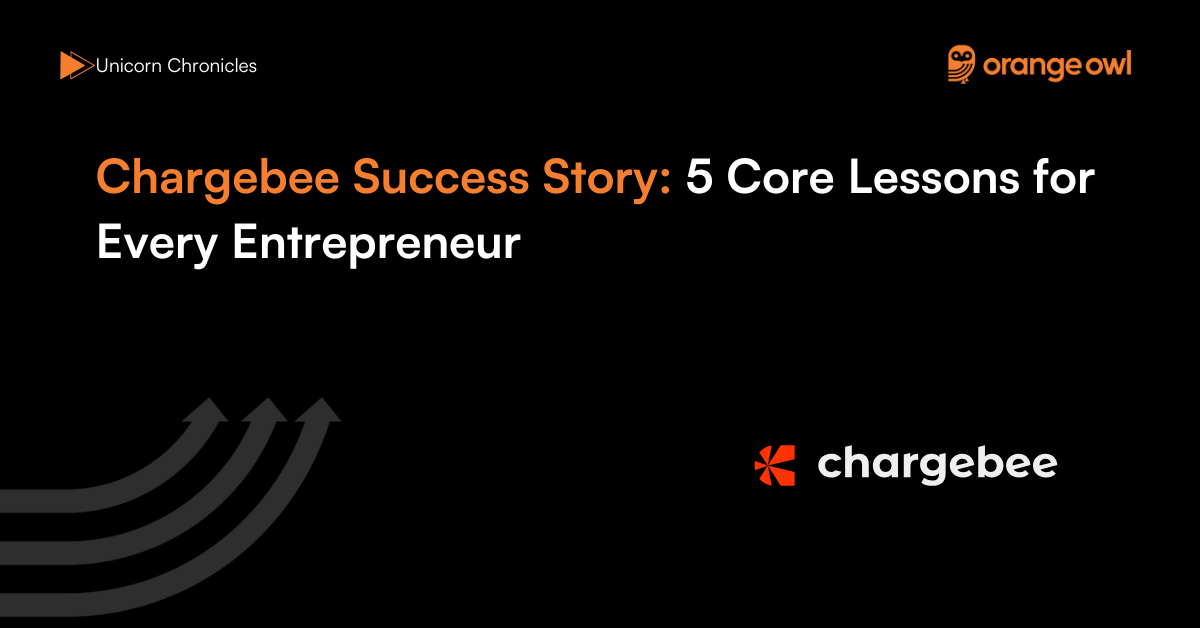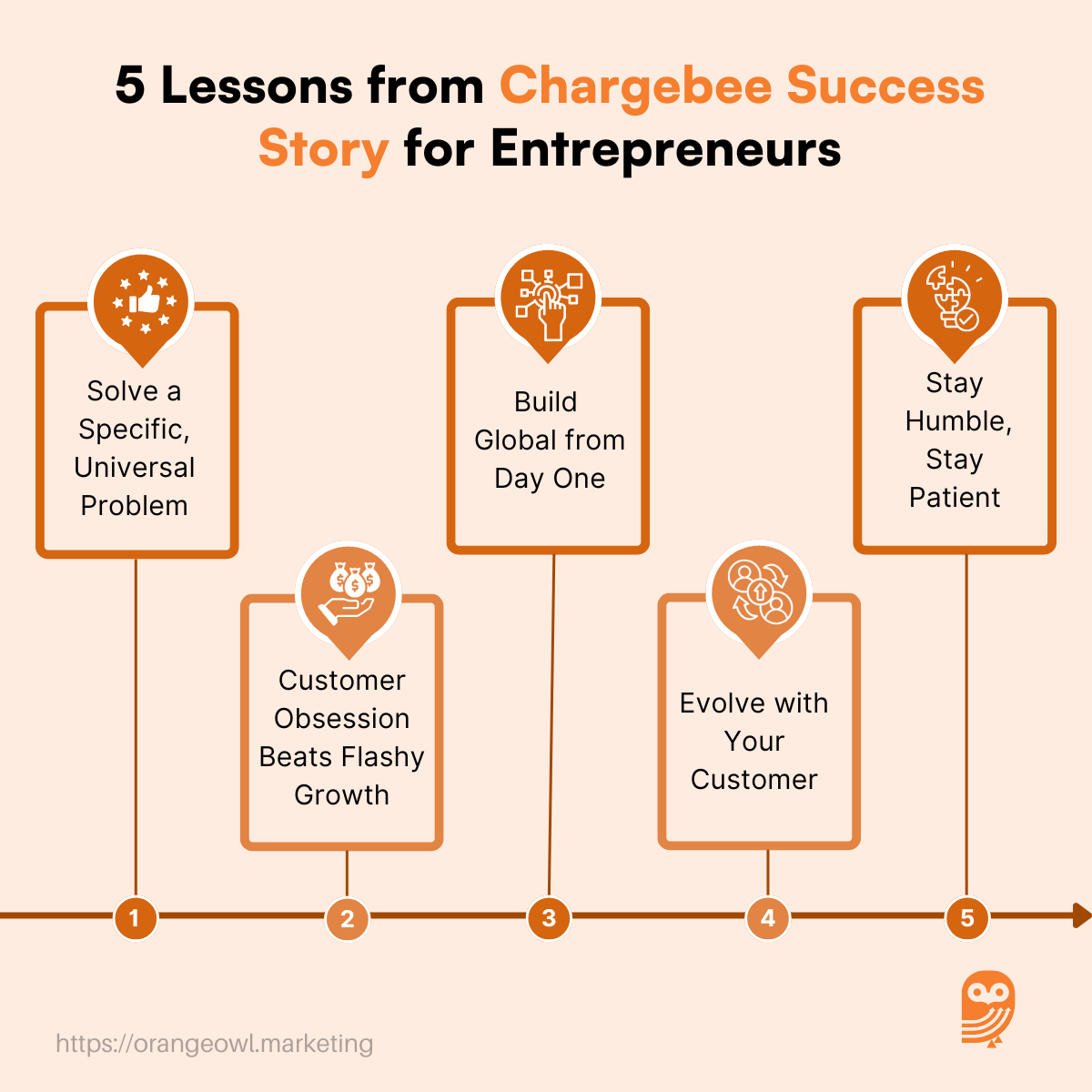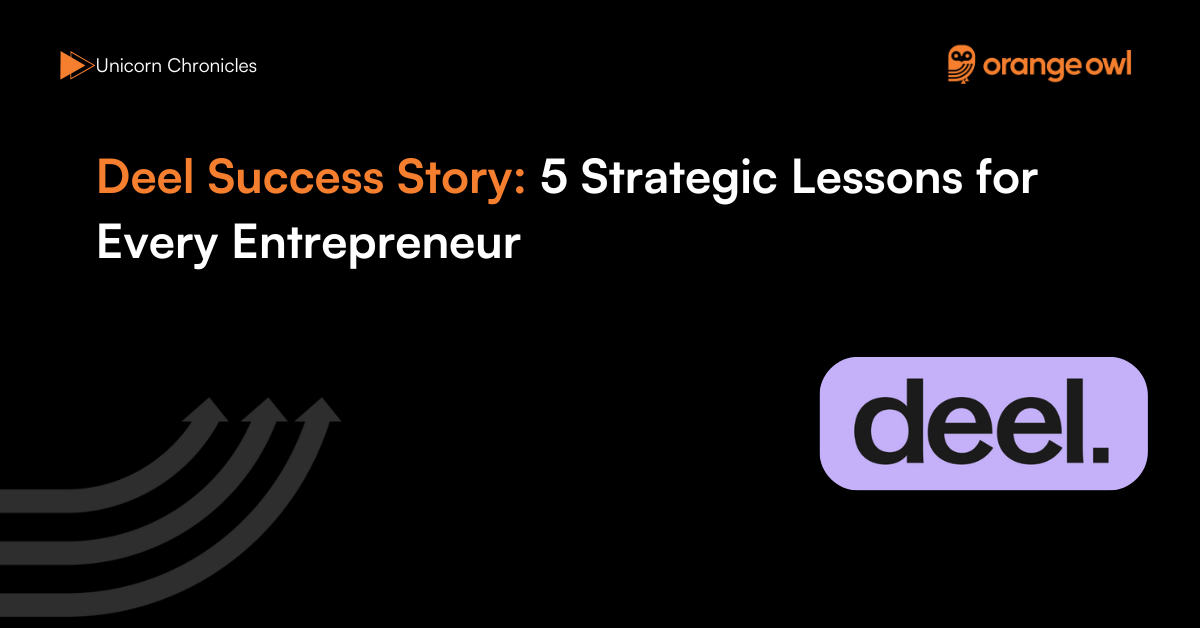Chargebee Success Story: 5 Core Lessons for Every Entrepreneur
Vivek Goel
April 30, 2025

Table of Contents
Introduction
In the rapidly evolving world of Software-as-a-Service (SaaS), where recurring revenue models are becoming the backbone of modern business, Chargebee has established itself as a global leader in subscription billing and revenue operations. Founded in 2011 by four college friends—Krish Subramanian, Rajaraman Santhanam, Thiyagarajan T, and Saravanan KP—Chargebee set out with a clear vision: to simplify and automate subscription management for businesses worldwide.
What began as a modest startup in Chennai, India, has since transformed into a SaaS unicorn valued at over $3.5 billion, following its 2022 funding round led by Tiger Global and Sequoia Capital. The company now serves over 4,500 customers across 60+ countries, including high-growth businesses like Freshworks, Calendly, Okta, and Pret a Manger.
Chargebee’s journey is more than just a case study in SaaS excellence—it is a masterclass in product-led growth, customer empathy, and resilient entrepreneurship. In this blog, we unpack the origin story of Chargebee, the early hurdles they faced, and the strategic moves that fueled their rise. Most importantly, we extract five Core lessons that every entrepreneur can apply, whether they’re building a SaaS startup or scaling a B2B tech venture.
Origin Story
Chargebee’s inception stemmed from a first-hand understanding of a universal SaaS challenge—the complexity of managing recurring billing at scale. The company was founded in 2011 by Krish Subramanian, Rajaraman Santhanam, Thiyagarajan T, and Saravanan KP, four college friends with engineering backgrounds who saw how growing SaaS startups struggled with managing billing cycles, freemium models, upgrades, cancellations, taxes, and compliance across geographies.
At the time, businesses had to either build their own in-house billing system or rely on clunky enterprise tools that weren’t designed for SaaS models. Chargebee’s founders envisioned a plug-and-play platform—as simple and essential as cloud storage or email hosting—that would let startups handle all aspects of subscription management with minimal friction.
“We didn’t start with a grand business plan. We just saw a real problem and focused on building a product that could solve it elegantly.”— Krish Subramanian, Co-founder & CEO
Rather than rush to launch, the team committed to deep product development. For over 14 months, they built and refined Chargebee before onboarding their first customer—a level of patience that’s rare among early-stage startups. Their philosophy was simple: solve a real problem better than anyone else, and product-market fit would follow naturally. This deliberate, feedback-driven development cycle laid the foundation for the robust and scalable product Chargebee is known for today.
Business Landscape and Early Challenges
In 2011, the Indian startup ecosystem was still in its infancy, especially in the SaaS domain. The concept of recurring billing was just taking shape globally, and there were few role models to emulate. Most existing billing software catered to large enterprises, often bloated with features irrelevant to startups or too rigid to adapt to fast-evolving SaaS needs.
Chargebee, bootstrapped in its early days, faced the daunting challenge of competing against better-funded global incumbents. Being based in India also came with perception barriers—many potential clients in the U.S. were skeptical about the product’s reliability, scalability, and support quality.
Despite this, the founders leaned into one major differentiator: customer obsession.
“We couldn’t out-market others. We had to out-listen and out-serve. That’s what helped us win those crucial first 100 customers.”— Rajaraman Santhanam, Co-founder & COO
By focusing intensely on feedback, ensuring fast turnaround times, and delivering a consistently intuitive experience, Chargebee gradually earned trust. Their first 100 customers, many of them small but global SaaS startups, became passionate advocates. Chargebee’s early growth was driven by word-of-mouth and community credibility, not marketing dollars.
This unwavering focus on customer success, coupled with developer-friendly APIs, robust documentation, and a deep understanding of SaaS workflows, gave Chargebee its first big break—eventually attracting the attention of major VC firms like Accel and Tiger Global in later years.
Growth Strategies
Chargebee’s growth was far from impulsive—it was deliberate, modular, and deeply aligned with the evolving needs of SaaS businesses. From day one, the team prioritized building an API-first product that could integrate easily with widely used tools like Stripe, Salesforce, QuickBooks, and HubSpot, enabling seamless onboarding and minimal disruption to existing systems. This plug-and-play capability made Chargebee a natural fit for startups looking to scale quickly without technical bottlenecks.
Their modular architecture not only supported diverse business models but also helped the company scale up the customer ladder—starting with early-stage SaaS startups and gradually adding mid-market and enterprise clients into the fold. The flexibility of the platform played a key role in Chargebee becoming a trusted revenue infrastructure partner for businesses in over 60 countries.
Chargebee’s momentum attracted marquee investors. The company raised over $470 million across multiple rounds, with Tiger Global, Insight Partners, Steadview Capital, and Sequoia Capital among its backers. In February 2022, Chargebee raised a $250 million Series H round, pushing its valuation to over $3.5 billion.
To future-proof its platform and enter broader revenue management territory, Chargebee made strategic acquisitions. In 2021, it acquired RevLock to automate revenue recognition and Brightback to improve customer retention through intelligent churn analytics. These moves allowed them to evolve from a billing solution to a comprehensive revenue operations platform.
“We evolved from being a billing company to a revenue operations platform. That transition was crucial for long-term relevance.”— Krish Subramanian, Co-founder & CEO
Marketing Strategies
Chargebee’s marketing approach has consistently mirrored its product philosophy: educational, transparent, and value-driven. Instead of aggressive outbound campaigns, the company doubled down on inbound content—publishing SEO-optimized blogs, whitepapers, case studies, and deep product documentation that addressed real challenges SaaS founders and CFOs face, such as churn management, ARR forecasting, and tax compliance.
Their developer-focused documentation and sandbox environments also played a significant role in boosting product adoption, making it easier for engineering teams to test, implement, and customize Chargebee’s features without sales interference.
Chargebee also invested heavily in community visibility. They were frequent participants in global SaaS conferences such as SaaStr Annual, Web Summit, and SaaSBOOMi, using these platforms to establish thought leadership and connect with a global network of SaaS operators.
One of their most effective strategies was the freemium model, which allowed startups to use Chargebee at no cost until they reached a certain revenue threshold. This created a strong product-led growth engine, where startups could test the platform early and naturally convert to paid plans as they scaled.
“Our best marketing has always been our product—and the trust we build by helping customers grow.” — Saravanan KP, Co-founder
By combining developer advocacy, educational content, and smart pricing strategies, Chargebee turned marketing into a channel for value delivery, not just lead generation.
5 Core Lessons Every Entrepreneur Should Learn from Chargebee
1. Solve a Specific, Universal Problem
When Chargebee launched, the subscription economy was gaining traction, but billing systems were clunky, inflexible, and designed for legacy enterprises. Instead of chasing multiple use cases, Chargebee zeroed in on a singular, painful challenge—simplifying recurring billing for SaaS companies. They built a product that allowed businesses to manage trials, upgrades, proration, taxation, and compliance effortlessly. By mastering this niche problem, they became indispensable to their users.
“We didn’t want to be everything for everyone. We wanted to solve one thing exceptionally well.” — Krish Subramanian, CEO
Lesson: Don’t over-engineer or build for scale on day one. Start with a focused problem that a large number of people care deeply about. Solve it so well that customers can’t imagine switching.
2. Customer Obsession Beats Flashy Growth
While many startups burn capital chasing rapid user acquisition, Chargebee chose a path of obsessive customer empathy. They listened closely, iterated thoughtfully, and ensured their product was both robust and easy to use. Their success came from delivering value before selling hard. Clean API documentation, timely support, and intuitive onboarding won them advocates, not just users.
“You can’t always out-market your competitors, but you can out-serve them.” — Rajaraman Santhanam, Co-founder & COO
Lesson: Growth that stems from customer love is more sustainable than growth driven by ads. Listen more, support better, and earn trust by genuinely being useful.
3. Build Global from Day One
Despite starting in Chennai, Chargebee never saw geography as a constraint. Their product was built with global compliance, UX sensibilities, and scalability in mind. By integrating with tools like Stripe and Salesforce and adhering to global standards like PCI DSS, they positioned themselves as a serious contender for businesses around the world—from San Francisco to Stockholm.
Within a few years, the majority of their revenue came from outside India—proof that location is irrelevant when the product is world-class.
Lesson: Build with a global mindset. Your first customers may be local, but your future is international. Invest in quality, standards, and integrations that scale beyond borders.

4. Evolve with Your Customer
Chargebee’s evolution was guided not by trends but by the maturing needs of its customers. As their users scaled, they needed more than billing—they needed revenue recognition, churn prediction, usage-based pricing, and revenue operations tools. Chargebee responded with timely acquisitions like Brightback and RevLock, expanding their suite into a full-fledged revenue growth platform.
“Our roadmap was shaped by the pain points we heard repeatedly from our customers.” — Krish Subramanian
Lesson: Keep your ears to the ground. Customers often signal what they’ll need next. Stay close to them and use those insights to guide your product evolution.
5. Stay Humble, Stay Patient
Chargebee didn’t rush into fundraising or branding blitzes. For years, they bootstrapped, focusing on building a strong foundation. Even as venture capital became available, they were deliberate in choosing partners who aligned with their long-term vision. Their patience paid off—when they did scale, it was with confidence and stability, not chaos.
“We weren’t chasing unicorn badges. We were chasing product excellence.” — Krish Subramanian
Lesson: Don’t confuse speed with progress. Some of the best companies grow slowly but steadily, staying grounded in their mission. Focus on what matters—solving problems well and growing responsibly.
Conclusion: Key Takeaways from Chargebee’s Journey
Chargebee’s rise isn’t the tale of a startup that exploded overnight with a viral product or aggressive funding. It is a masterclass in slow, strategic scaling—a case study in what happens when founders combine deep domain insight with humility, patience, and laser-sharp customer focus. From writing their first lines of code in a modest apartment in Chennai to powering subscription revenue for businesses in over 100 countries, the company’s journey is a powerful affirmation of what’s possible when execution trumps hype.
What sets Chargebee apart is its consistency of purpose. The founders never lost sight of the original pain point they set out to solve—simplifying recurring billing. But as their customers grew, so did their ambitions. They didn’t pivot wildly or dilute their focus. Instead, they layered their offerings—billing, revenue recognition, churn management—deliberately and cohesively. Every product decision, acquisition, and GTM strategy aligned with their vision of becoming the backbone of subscription businesses globally.
“You don’t need to start with a unicorn vision. You need to start with a problem worth solving, and the grit to solve it better than anyone else.” — Krish Subramanian, CEO of Chargebee
For aspiring entrepreneurs, especially in India’s burgeoning SaaS ecosystem, Chargebee is more than just a unicorn—it’s a playbook. It teaches us that global products can be built from anywhere. That bootstrapping is not a limitation but a discipline. And that real growth is rooted not in vanity metrics, but in delivering value every single day.


